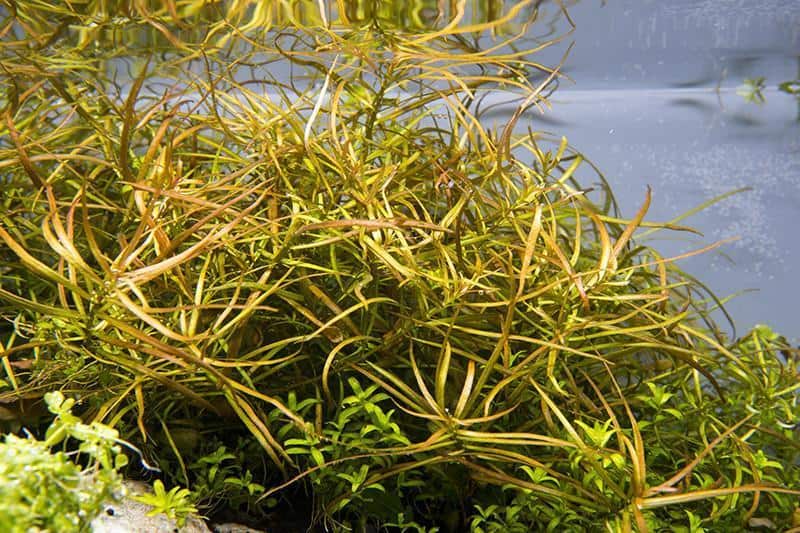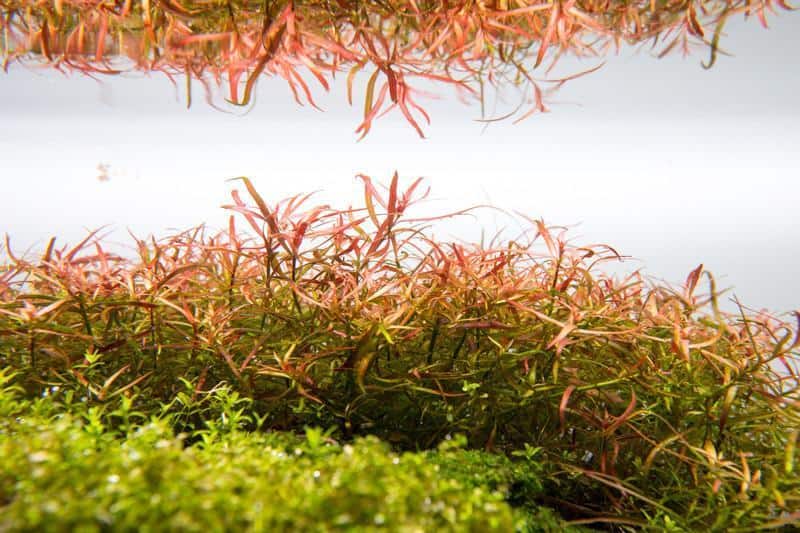Here is another top-of-the-line perennial herb when it comes to aquarium plants. The delicate-looking stem plant, ludwigia arcuata is a mainstay in every retailer online because it is one of the favorites in horticulture and aquascaping trade.
The plant exhibits hues of red and brown that is good enough to accentuate your underwater landscape.
We mainly recognize Ludwigia arcuata by its daintiness and beautiful coloration.
Scientific Facts
- Family: Onagraceae
- Genus: Ludwigia
- Plant Structure: Stem
- Plant Division: Angiosperms (Flowering Plant)
- Group: Dicot
- Duration: Perennial
- Growth Habit: Herbaceous
Other Known Names
- Needle Leaf Ludwigia
- Ludwigia Needle Leaf
- Narrow Leaf Ludwigia
- Pond seedbox
Synonyms (Similar Plants)
Ludwigia arcuata can be mistaken with other Ludwigia species like:
- Ludwigia brevipes
- Ludwigia palustris
- Ludwigia repens
- Ludwigia X lacustris (hybridized)
- Ludwigia palustris
These species of Ludwigia herbs are known to grow together and can reproduce hybrid offspring. This makes it difficult to accurately identify one from the other, thus resulting in more confusion.
Studies proved that Ludwigia arcuata (pond seedbox) and Ludwigia repens (creeping seedbox) could produce a hybrid offspring that completely resembles the water purslane, Ludwigia palustris (Long Beach seedbox)
Origin, Spreadability, and Distribution
Needle Leaf Ludwigia, which is native to North America, can be found growing in submersed and emersed forms. Aquarists found them in wetlands, marshes, swamps, pond margins and drainage ditches in the Southeastern United States, primarily in Florida, Georgia, South and North Carolina, Maryland, Virginia, and New Jersey. Its widespread distribution grew tremendously to other parts of the horticulture world, gaining much attention to fauna and foliage lovers.
Morphology and Characteristics

This perennial herb used to grow naturally in emersed and submersed forms. When it grows on wetlands (emersed) it has prostrated to branch out while on its submerged state, the growth habit is ascending.
When grown above the surface of the water, its leaf shape appears lanceolated in green color. When grown submersed, leaves are narrower and longer in a reddish-brown color.
The foliage has a dark red stem and needle-like shaped leaves that can either be green or red. The green leaves will eventually turn to deep red or brownish color depending on the light (or sunlight) provided.
Four yellow-petal flowers measuring ¼ inches with four green triangular sepals are formed from the leaf axils. Ludwigia arcuata produces its fruits on stalks of about ⅝ - 1⅜ inches long or equivalent of 1.5 - 3.5 in centimeters.
Despite looking fragile and delicate, it is very hardy and when maintained under healthy conditions will grow into delicate bushy clusters that can reach 20" in height.
Habitat and Adaptability
This herbaceous plant can invasively grow in its natural habitat like in shallow water, pond shores and swamps. Wet meadows and most aquatic ecosystems are similar types of wetlands where this species dwell and thrive.
They can also be seen creeping along wetlands like depression ponds, swales, shores of impoundments, marshes, mires (bogs and fens) and even ditches or granite-outcrop pools.
However, they can also survive in your tank provided of proper environment and needed nutrients. They can adapt in both natural and adapted conditions as long as they will receive good lighting or direct sunlight.
Environmental Concern for this Plant
Several threats made by men can be detrimental to the species like:
- Draining
- Ditching
- Filling of wetlands
- Impoundment of streams
- Coastal development.
Note: As per Georgia Conservation Status, these species of plants are becoming endangered on several of its known habitats, and already disappeared in Georgia for many years now.
To preserve and conserve the species of flora and fauna, the government should protect wetland areas from ditching, filling and draining. They must maintain coastal habitats from getting developed.
Guidelines for ludwigia arcuata care
If you are a plant lover, you are aware by now that this hydrophytic type of plant is not at all demanding. The stems looked fragile though, but they are sturdy.
Being a hydrophyte is an aquatic plant growing totally or partially submerged in water. It can also mean a creeping stem plant that grows in waterlogged or dampens the soil.
There are factors affecting their growth, but definitely, there are reasons for their immediate extinction. If humans take care of every fish and plant species, they will bring us many benefits in return.
We can also partake in disseminating awareness to protect depression wetland areas from developing, dumping, off-road vehicle usage, clearing, filling, and draining. The natural water levels must be preserved from depleting and excessive draw-down. Placing firebreaks in transition zones between highlands and wetlands should be avoided.
Through enough exposure to sun or light, balanced nutrition and sufficient supply of their needs, the plant will grow healthy in such a conducive environment. Add your loving touch, and they will give you a wondrous sight to behold.
Nutrition for ludwigia arcuata

The Needle-Leaf Ludwigia is a photoautotroph type of plant. It has structures known as chloroplasts that capture the sunlight that enables photosynthesis.
Such a process provides autotrophic nutrition for the plants to create their food and colorate vibrantly.
It is synonymous with the lighting you provide in your aquarium. Every plant's vital requirement is sufficient light.
To reach its potential, the light should be set from medium to high. Deep red coloration can be achieved with optimum lighting.
Like other aquatic plants, ludwigia arcuata care should include nutrients from various minerals in the substrate or soil, such as phosphorous and nitrogen, iron, nitrates, potassium, and its needed trace elements.
Micronutrient fertilizers aid to augment the plant's coloration from its shoot apex to the leaf's undersides. Sufficient macronutrients contribute to its health as well. They are derived from foods you feed your fish.
The ideal temperature for this versatile plant to adapt well is 20 to 28°C/68 to 82°F. It also gets nutritional aids from water so the water conditions must be 72 to 82° F, KH should be 3-11 and pH level is at 5.5-7.8. Hardness is estimated soft to medium.
With carbon dioxide supplementation, you can achieve the best tank momentum. Add extra care with carbon monoxide in high-lighted tanks and make sure the plants don't fall short of nutrients that might deform its growth.
The injection of CO2 is not an essential requirement for healthy cultivation of this species, but it can sustain its robust growth. Another thing, you may notice that low level of nitrogen in the water columns can induce much deeper red tones for this type of plant.
Decorating with ludwigia arcuata
This perennial plant is typically purchased in bunches of stems according to the lighting each bunch needs. One is marked to adapt to moderate light while the others for high brightness.
The color of its leaves and stems will significantly depend on the light intensity. In low light, it maintains its natural green color, while it turns yellow to orange in medium lighting. When light intensifies, the plant turns into shades of red.
Decorating with the Needle Leaf Ludwigia is also similar to other Ludwigia species. It can be considered as a midground highlight of your underwater landscape.
The miniature ludwigia arcuata will perfectly fit your aquarium no matter what the size is. It is undemanding of care, and it thrives prolifically in any water parameters. You may want these aquaria plants on the foreground or background applications.
For nano aquarium types it is recommended to place clusters of stems in the middle ground. For broader and larger tanks it is an ideal backgrounder.
Since the plant looks thin in its appearance, it is recommended to plant them in clusters of six or twelve shoots each. These groupings in vibrant red and golden brown leaves can accentuate the front view and middle area of the aquarium.
In this regard, the plant creates a contrast to the dark background and can serve as an emphasis amongst small-leaved foliage like the Rotala species and the Hemianthus glomeratus.
This herbaceous plant creates thick bushes in any areas of the aquarium if frequently pruned. It serves as a filtered shade to the bottom ground when grown emersed.
In shallow tanks of high lighting, the Needle Leaf Ludwigia can grow emersed to the water surface. It will thrive horizontally, producing dainty yellow flowers that can add allure to the overall setup.
Method of Propagation
All Ludwigia species are perennial herbs that can reproduce sexually but can also thrive through rooting at its nodes. Most species of Ludwigia undergo pollination through bees, butterflies and flies, yet they are also self-pollinating.
In its natural habitat reproduction takes place in late spring up until summer. That's the flowering season for mature emersed Ludwigia plants.
Its yellow flowers will produce seeds that when fully developed, will gradually drop to the ground to start developing roots, hence creating new plants.
The process is also similar when raising the plants in an aquarium. The only difference is the pruning method.
Growth is way slower for a lot of stem plants, making maintenance a lot of ease. Trimming the topmost part of the plant enables new shoots to emerge from their nodes.
Doing this process regularly will result in a bushy-look that plant growers ideally desire.
Through regular cutting of the long stems, branches, and side shoots, they can be planted anew in the substrate to multiply the bunch. Sufficient spacing when replanting should be observed so the herbaceous plants could creep into a mat avoiding a small bushy state.
For healthy root growth, remove the leaves from the last node of the stem before replanting. Other trimmings from the topmost of the bush will drop off the substrates to propagate anew.
These hydrophyte plants can also propagate in an emersed state in viquariums, paludariums, and terrariums. They can be dwarfed in vitro cups and likewise be cultured in horticulture laboratories to ensure a pest-free environment.
Final Thoughts
Needle Leaf Ludwigia offers a relaxing sight as it sways gracefully in the currents of the water. Aquascapers are attracted to this plant because of the movement it exhibits along with the shades of red hues.
It adds dimension to the concept it portrays. Ludwigia arcuata has something to convey with its delicate appearance that bears elegance in every way.

